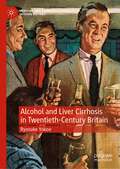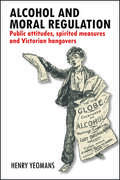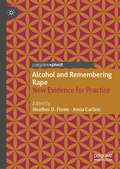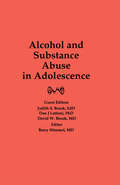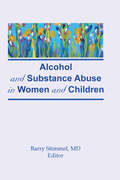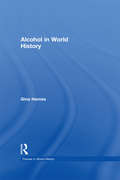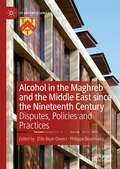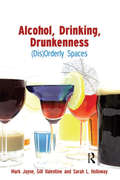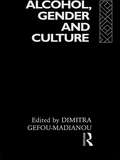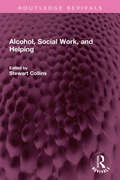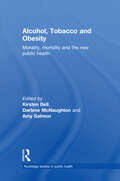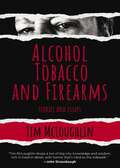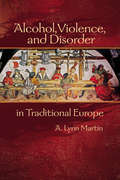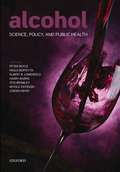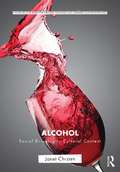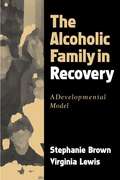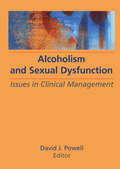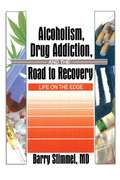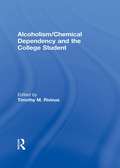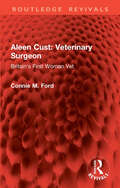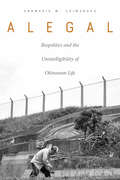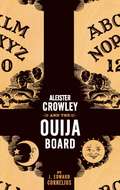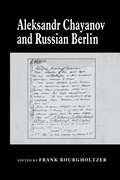- Table View
- List View
Alcohol and Liver Cirrhosis in Twentieth-Century Britain (Medicine and Biomedical Sciences in Modern History)
by Ryosuke YokoeThe relationship between alcohol consumption and liver cirrhosis has long been contested by doctors and medical professionals, creating numerous implications for the public reputation of alcohol in Britain. Despite this, it was not until the 1970s that cirrhosis came to be understood as an ‘alcoholic disease’. This book contextualises developments in this debate through the twentieth century by examining the significant influence that medical expertise had on policy responses to alcohol misuse, as well as the social reputation of alcohol consumption. It demonstrates how the degree to which drinking was seen to be responsible for liver disease directly shaped how different groups, such as the temperance movement and the drinks industry, exaggerated or downplayed the destructive properties of alcohol. Covering a series of themes including the science of disease causation, the social standing of medical expertise, and alcohol and public health policy, this book argues that in order to properly understand the trajectory of debates around drinking we need to consider the twentieth-century ‘alcohol problem’ as primarily a medical issue. Contrary to the tendency by existing works to disassociate perceptions and responses to alcohol use from the objective knowledge of its effects on the body, this book shows that medical understandings of liver disease influenced how alcohol was conceptualised in relation to its harms. Offering a fresh perspective on the interaction between scientific knowledge and policy during the twentieth century, this book provides insights for those researching the social, political and cultural history of modern Britain, as well as historians of medicine and health.
Alcohol and Moral Regulation: Public Attitudes, Spirited Measures and Victorian Hangovers
by Henry YeomansAlcohol consumption is frequently described as a contemporary, worsening and peculiarly British social problem that requires radical remedial regulation. Informed by historical research and sociological analysis, this book takes an innovative and refreshing look at how public attitudes and the regulation of alcohol have developed through time. It argues that, rather than a response to trends in consumption or harm, ongoing anxieties about alcohol are best understood as ‘hangovers’ derived, in particular, from the Victorian period. The product of several years of research, this book aims to help readers re-evaluate their understandings of drinking. As such, it is essential reading for students, academics and anyone with a serious interest in Britain’s ‘drink problem’.
Alcohol and Remembering Rape: New Evidence for Practice
by Anna Carline Heather D. FloweThis book examines how alcohol intoxication impacts upon the memory of rape victims and provides recommendations for how best to investigate and prosecute such rape complaints. An estimated 75% of victims are under the influence of alcohol during a sexual assault and yet there is surprisingly little guidance on conducting interviews with complainants who were alcohol-intoxicated during the attack. This book will provide a distinctive, rigorous and important contribution to knowledge by reviewing the evidence base on the effects of alcohol on memory performance. The book brings together a range of academics from various disciplines, including psychology, law and criminology, and it discusses the implications for practice based on consultation with various criminal justice practitioners, including police officers, barristers who defend and prosecute rape cases and policy makers.
Alcohol and Substance Abuse in Adolescence
by Barry Stimmel Judith BrookThis timely volume explores the possible reasons that young people turn to drugs, the most effective methods to manage those who are afflicted, and ways to educate youth to prevent their initial drug involvement.
Alcohol and Substance Abuse in Women and Children
by Barry StimmelHere is a timely volume that examines the problems of substance abuse in women and children, with a particular emphasis on the role played by the family in the development and perpetuation of the problem.
Alcohol in World History (Themes in World History)
by Gina HamesFrom the origins of drinking to the use and abuse of alcohol in the present day, this global historical study draws on approaches and research from biology, anthropology, sociology and psychology. Topics covered include: the impact of colonialism alcohol before the world economy industrialization and alcohol globalization, consumer society, and alcohol. Gina Hames argues that the production, trade, consumption, and regulation of alcohol have shaped virtually every civilization in numerous ways. It has perpetuated the development of both domestic and international trade; helped create identity and define religion; provided a tool for oppression as well as a tool for cultural and political resistance; and has supplied governments with essential revenues as well as a means of control over minority groups. Alcohol in World History is one of the first studies to pull together such a wide range of sources in order to compare the role of alcohol throughout time and across both western and non-western civilizations.
Alcohol in the Maghreb and the Middle East since the Nineteenth Century: Disputes, Policies and Practices (St Antony's Series)
by Elife Biçer-Deveci Philippe BourmaudThis book explores the significance of alcohol in the Middle East and Maghreb as a powerful catalyst of social and political division. It shows that the solidarities and polarities created by disputes over alcohol are built on arguments far more complex than oppositions on religion or consumption alone. In a region in which alcohol is banned by Islamic rules, yet allows its production and consumption, alcohol has always been contentious. However, this volume examines the different forms of social authority – religious, cultural and political – to offer a new understanding of drinking behaviours in the Middle East and North Africa. It suggests that alcohol, being at the same time an import and product of local industry, epitomises the tensions inherent to the conforming of Islamic societies to global trends, which seek to redefine political communities, social hierarchies and gender roles. The chapters challenge common misconceptions about alcohol in this region, arguing instead that medical discourses on alcohol dependency hide stances on national independence in an imperialist context; that the focus on religion also tends to conceal disputes on alcohol as a social struggle; and that disputes on inebriation are more about masculinity than judging private leisure. In doing so, the volume presents alcohol as a way of grasping the power relations that structure the societies of the Middle East and Maghreb.
Alcohol, Drinking, Drunkenness: (Dis)Orderly Spaces (Studies In Early Medieval Britain Ser.)
by Gill Valentine Sarah L. Holloway Mark JayneWhile disciplines such as anthropology, sociology, politics, social policy and the health and medical sciences have a tradition of exploring the centrality of alcohol, drinking and drunkenness to people's lives, geographers have only previously addressed these topics as a peripheral concern. Over the past few years, however, this view has begun to change, accelerated by an upsurge in interest in alcohol consumption relating to political and popular debate in countries throughout the world. This book represents the first systematic overview of geographies of alcohol, drinking and drunkenness. It asks what role alcohol, drinking and drunkenness plays in people's lives and how space and place are key constituents of alcohol consumption. It also examines the economic, political, social, cultural and spatial practices and processes that are bound up with alcohol, drinking and drunkenness. Designed as a reference text, each chapter blends theoretical material with empirical case studies in order to analyse drinking in public and private space, in the city and the countryside, as well as focusing on gender, generations, ethnicity and emotional and embodied geographies.
Alcohol, Gender and Culture (European Association of Social Anthropologists)
by Dimitra Gefou-MadianouEuropeans consitiute 12 and a half per cent of the world's population but consume 50 per cent of the recorded world production alcohol, and this consumption plays a significant role in the cultural, religious, and social identites of these countrise. The contributors show how different groups define the proper use of alcohol, how State policies may effect drinking behaviour, and highlight how beverages and comestibles must be seen in relation to each other. From this is it shown how importamt socio-cultural distinctions are made between and within communities, gender relations, ethnic groups, and socio-economic groups, and within religious ideologies; what one drinks, how one drinks, with whom, and where, all influence not how alcoholic substances are regarded but how social relations are experienced. Alcohol Gender and Culture clearly demonstrates how the social construction of drinking may provide an analytical tool with which to approach different socio-cultural groups and illustrates how any cultural group can be compared to another by its attutudes to alcohol. It will be invaluable reading for students and lecturers af anthropology, cultural history and gender studies.
Alcohol, Social Work, and Helping (Routledge Revivals)
by Stewart CollinsFirst published in 1990, Alcohol, Social Work and Helping provides coherent and imaginative advice on how to counsel the growing number of clients whose use of alcohol causes of problems. It locates intervention within societal and agency contexts and tackles such practical issues as: how to work with a problem drinker; which short-term goals to suggest; what kind of help to apply; and how to assist in the event of a relapse. The contributors, with backgrounds in academic, statutory, and voluntary settings, focus on key areas of intervention, family, and group contexts, and there is a chapter on the particular circumstances and needs of women. All relevant information – both general and specialized – is presented in a clear, easy-to-read style, and is aimed at developing existing knowledge and skills. This book will be of interest to students of health, social work, and sociology.
Alcohol, Tobacco and Obesity: Morality, mortality and the new public health
by Amy Salmon Kirsten Bell Darlene McNaughtonAlthough drinking, smoking and obesity have attracted social and moral condemnation to varying degrees for more than two hundred years, over the past few decades they have come under intense attack from the field of public health as an 'unholy trinity' of lifestyle behaviours with apparently devastating medical, social and economic consequences. Indeed, we appear to be in the midst of an important historical moment in which policies and practices that would have been unthinkable a decade ago (e.g., outdoor smoking bans, incarcerating pregnant women for drinking alcohol, and prohibiting restaurants from serving food to fat people), have become acceptable responses to the 'risks' that alcohol, tobacco and obesity are perceived to pose. Hailing from Canada, Australia, the United Kingdom and the USA, and drawing on examples from all four countries, contributors interrogate the ways in which alcohol, tobacco and fat have come to be constructed as 'problems' requiring intervention and expose the social, cultural and political roots of the current public health obsession with lifestyle. No prior collection has set out to provide an in-depth examination of alcohol, tobacco and obesity through the comparative approach taken in this volume. This book therefore represents an invaluable and timely contribution to critical studies of public health, health inequities, health policy, and the sociology of risk more broadly.
Alcohol, Tobacco, and Firearms: Stories And Essays
by Tim McLoughlinAn enthralling collection of short fiction and nonfiction that draw upon McLoughlin's three-decade career in the criminal justice system. In Alcohol, Tobacco, and Firearms, Tim McLoughlin draws upon his three-decade career in the criminal justice system with his characteristic wit and his fascination with misfits and malfeasance. A lifetime immersed in New York City feeds short stories that evoke a landscape of characters rife with personal arrogance and misjudgment; and nonfiction essays about toeing the line when the line keeps disappearing. An opioid-addicted catsitter electronically eavesdrops on his neighbors only to hear devastating truths. A degenerate gambler stakes his life on a long shot because he sees three lucky numbers on the license plate of a passing car. In the nonfiction essays, we learn that the system plays a role in supporting vice, as long as it gets a cut. Altar boys compete to work weddings and funerals for tips in the shadow of predatory priests. Cops become robbers, and a mob boss just might be a civil rights icon. McLoughlin shines a light on worlds that few have access to. A recurring theme in his urban, often New York–centric work is chronic displacement, people standing still in a city that is always changing. These are McLoughlin’s ghosts, these casualties of progress, and he holds them dear and celebrates them.
Alcohol, Violence, and Disorder in Traditional Europe (Early Modern Studies #2)
by A. Lynn MartinTraditional Europe had high levels of violence and of alcohol consumption, both higher than they are in modern Western societies, where studies demonstrate a link between violence and alcohol. A. Lynn Martin uses an anthropological approach to examine drinking, drinking establishments, violence, and disorder, and compares the wine-producing south with the beer-drinking north and Catholic France and Italy with Protestant England, and explores whether alcohol consumption can also explain the violence and disorder of traditional Europe.Both Catholic and Protestant moralists believed in the link, and they condemned drunkenness and drinking establishments for causing violence and disorder. They did not advocate complete abstinence, however, for alcoholic beverages had an important role in most people's diets. Less appreciated by the moralists was alcohol's function as the ubiquitous social lubricant and the increasing importance of alehouses and taverns as centers of popular recreation.The study utilizes both quantitative and qualitative evidence from a wide variety of sources to question the beliefs of the moralists and the assumptions of modern scholars about the role of alcohol and drinking establishments in causing violence and disorder. It ends by analyzing the often-conflicting regulations of local, regional, and national governments that attempted to ensure that their citizens had a reliable supply of good drink at a reasonable cost but also to control who drank what, where, when, and how.No other comparable book examines the relationship of alcohol to violence and disorder during this period.
Alcohol, Violence, and Disorder in Traditional Europe (Early Modern Studies)
by A. Lynn MartinTraditional Europe had high levels of violence and of alcohol consumption, both higher than they are in modern Western societies, where studies demonstrate a link between violence and alcohol. A. Lynn Martin uses an anthropological approach to examine drinking, drinking establishments, violence, and disorder, and compares the wine-producing south with the beer-drinking north and Catholic France and Italy with Protestant England, and explores whether alcohol consumption can also explain the violence and disorder of traditional Europe.Both Catholic and Protestant moralists believed in the link, and they condemned drunkenness and drinking establishments for causing violence and disorder. They did not advocate complete abstinence, however, for alcoholic beverages had an important role in most people's diets. Less appreciated by the moralists was alcohol's function as the ubiquitous social lubricant and the increasing importance of alehouses and taverns as centers of popular recreation.The study utilizes both quantitative and qualitative evidence from a wide variety of sources to question the beliefs of the moralists and the assumptions of modern scholars about the role of alcohol and drinking establishments in causing violence and disorder. It ends by analyzing the often-conflicting regulations of local, regional, and national governments that attempted to ensure that their citizens had a reliable supply of good drink at a reasonable cost but also to control who drank what, where, when, and how.No other comparable book examines the relationship of alcohol to violence and disorder during this period.
Alcohol: Science, Policy and Public Health
by Paolo Boffetta Peter Boyle Albert B. Lowenfels Harry Burns Otis Brawley Witold Zatonski Jürgen RehmAlcohol has always been an issue in public health but it is currently assuming increasing importance as a cause of disease and premature death worldwide. Alcohol: Science, Policy, and Public Health provides an interdisciplinary source of information that links together, the usually separate fields of, science, policy, and public health. This comprehensive volume highlights the importance of bringing scientific knowledge to bear in order to strengthen and develop alcohol public policy. The book looks at the historical evolution of alcohol consumption in society, key early studies of alcohol and disease, and the cultural and social aspects of alcohol consumption. It then goes on to cover the chemistry and biology of alcohol, patterns of consumption, gender and age-related issues, alcohol and injury, alcohol and cancer and non-malignant disease, and various current therapeutic aspects. The book concludes with a section on alcohol policy, looking at issues of poverty, the availability of alcohol and alcohol control measures. This major reference, written by international leaders in the fields of alcoholism and alcohol policy, provides a comprehensive study of one of the foremost health problems in the world, and represents the highest standards of research within the field. It will be valuable to physicians and health professionals involved with patients with alcohol-related problems, scientists, public health specialists, health policy specialists, researchers and legislators as well as students of public health.
Alcohol: Social Drinking in Cultural Context (Routledge Series for Creative Teaching and Learning in Anthropology)
by Janet ChrzanAlcohol: Social Drinking in Cultural Context critically examines alcohol use across cultures and through time. This short text is a framework for students to self-consciously examine their beliefs about and use of alcohol, and a companion text for teaching the primary concepts of anthropology to first-or second year college students.
Alcoholic Family in Recovery
by Stephanie Brown Virginia M. LewisMost treatments for alcoholism have focused on abstinence as their final goal and emphasize brief interventions with the addicted individual. But family relationships change dramatically when the alcoholic stops drinking in fact, stress, turmoil, and uncertainty are the norm. This volume details how to help families regroup after abstinence, ride out periods of emotional upheaval, and find their way to establishing a more stable, yet flexible, family system. Using a compelling case-study format to illustrate the process of change, the book presents the moving personal experiences of families at different stages of the recovery process. Expanding the therapist's role to include psychoeducation and supportive counseling, the authors provide pointers for assessment at key stages of recovery and guide clinicians through bringing about lasting change.
Alcoholism and Sexual Dysfunction: Issues in Clinical Management
by Bruce CarruthExperts provide specific methodologies for clinicians working with recovering alcoholics and their families. This landmark study of sexual issues in alcoholism treatment addresses impotence in male alcoholics, the sexual dynamics of the client-counselor relationship, homosexual alcoholics, and many other important issues.
Alcoholism, Drug Addiction, and the Road to Recovery: Life on the Edge
by Barry StimmelGain a fuller understanding of substance addiction and treatment options!Originally published in 1992 as The Facts About Drug Use, this updated edition contains new information about the effects of alcohol and recreational, mood-altering drugs on the body. The multiple causes of drug use and the options available to those dependent on drugs as a way of life are thoroughly and clearly described. Drug use affects nearly 1 out of 2 Americans and cuts across every social and economic boundary. The effects of addiction on the individual are great, and the cumulative effects on society are staggering. Knowledge of the adverse effects of mood-altering drugs and why and how they are used excessively is a centerpiece of this book. It presents, intelligently and interestingly, ways to identify persons at risk and identify problems that the addicted encounter in attempts to become drug free. Alcoholism, Drug Addiction, and the Road to Recovery: Life on the Edge is an essential tool in both finding available resources for drug users and developing appropriate responses to today's drug problem.This remarkable, well-referenced book enables those with little or no background in science or health care to understand the complex issues surrounding drug use. It provides current, reliable, and unbiased information on methods for dealing with dependency upon alcohol and central nervous system depressants, hallucinogens, heroin, nicotine, marijuana, caffeine, amphetamines, designer drugs like Ecstasy, and steroids. A glossary listing common street names for drugs will be invaluable to those interested in identifying specific substances.This comprehensive volume will show you: who typically uses drugs and the reasons why they do how to classify mood-altering drugs how to identify and treat drug dependency areas of special concern such as multiple drug use, AIDS and drug use, drugs and pregnancy, drugs and sports, and drug testing technologyChapter by chapter, this nonjudgmental book helps readers develop a better understanding of the effects of mood-altering substances and the reasons many continue to use them despite serious consequences. This is a valuable key to the nature of dependency and addiction, and the external forces (including poverty and homelessness) that promote such behavior.
Alcoholism/Chemical Dependency and the College Student
by Leighton Whitaker Timothy RivinusProfessionals who work with college students--and college students themselves--address the current epidemic of drug use on college campuses in this timely book. In acknowledging that substance abuse problems proliferate during college and on into adult life when they then affect the next generation, the outstanding group of contributors offers forthright and clear descriptions, explanations, and suggestions for helping students, including examples of university services that have proven successful in dealing with student substance abuse. This helpful book aims to reverse the trend of ambivalence and confusion of administrators and college counselors regarding the area of substance use disorder by providing practical intervention strategies.
Alder Gulch
by Ernest HaycoxBLAZIN’ JUSTICEVirginia City, Montana. Gold fever struck hard in 1863, with miners pannin’ for nuggets up and down the length of nearby Alder Gulch. But a gang of guntoughs was ridin’ them roughshod. With the law lookin’ the other way, the sidewinders dealt out hot lead for a man shippin’ his poke or even carryin’ gold dust for his grubstake.Jeff Pierce had been on the hard dodge since Portland, until he staked his claim at Alder Gulch. As a favor, he carried another miner’s poke through the forty miles of danger to Bannack, only to find that the scummy gunhawks had filled the old-timer with buckshot. Now the varmints had Pierce as a marked man. The gang was fixin’ for a showdown, but they’d be a mite less cocky if they knew the charge he was up for—murder!“Ernest Haycox is a master and ALDER GULCH is one of his best.”—Dallas Times Herald
Aleen Cust Veterinary Surgeon: Britain's First Woman Vet (Routledge Revivals)
by Connie M. FordOriginally published in 1990, this book is a valuable contribution to the history of the veterinary profession in Great Britain and Ireland. Connie Ford’s book is a reminder of the great social changes that have taken place since Aleen Cust was born in 1868. When Aleen Cust entered the New Veterinary College, Edinburgh in 1895, and was later refused permission to sit the examinations of the Royal College of Veterinary Surgeons, no British woman had the vote. To the women students, only admitted to the London Veterinary College in 1927, she was a legend and an example. Now, a new generation of veterinarians, will find this account of the life and times of a truly remarkable woman a revelation.
Alegal: Biopolitics and the Unintelligibility of Okinawan Life
by Annmaria M. ShimabukuOkinawan life, at the crossroads of American militarism and Japanese capitalism, embodies a fundamental contradiction to the myth of the monoethnic state. Suspended in a state of exception, Okinawa has never been an official colony of the Japanese empire or the United States, nor has it ever been treated as an equal part of Japan. As a result, Okinawans live amid one of the densest concentrations of U.S. military bases in the world. By bringing Foucauldian biopolitics into conversation with Japanese Marxian theory, Alegal uncovers Japan’s determination to protect its middle class from the racialized sexual contact around its mainland bases by displacing them onto Okinawa, while simultaneously upholding Okinawa as a symbol of the infringement of Japanese sovereignty.This symbolism, however, has provoked ambivalence within Okinawa. In base towns that facilitated encounters between G.I.s and Okinawan women, the racial politics of the United States collided with the postcolonial politics of the Asia Pacific. Through close readings of poetry, reportage, film, and memoir on base-town life since 1945, Shimabuku traces a continuing failure to “become Japanese.” What she discerns instead is a complex politics surrounding sex work, tipping with volatility along the razor’s edge between insurgency and collaboration. At stake in sovereign powers’ attempt to secure Okinawa as a military fortress was the need to contain alegality itself—that is, a life force irreducible to the legal order. If biopolitics is the state’s attempt to monopolize life, then Alegal is a story about how borderland actors reclaimed its power for themselves.
Aleister Crowley and the Ouija Board
by J. Edward CorneliusPart fascinating history and part practical manual, this engaging guide takes the position that the Ouija Board is indeed as powerful as its detractors claim, revealing the dark secrets and hidden truths of this curious, enduring "game."
Aleksandr Chayanov and Russian Berlin
by Frank BourgholtzerAleksandr Chayanov lived and worked in England and Germany in the 1920s, when he wrote many letters. He was also forced to write autobiographical material after his arrest in 1930. Frank Bourgholtzer uses this material in his account of this Russian utopian.
